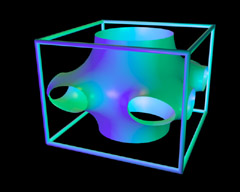|
|
Touching Soap Films |
|
|
|
Recent Results
The proof of the Plateau problem by Jesse Douglas ensures that a minimal surface exists for every given boundary contour. Nevertheless, there are still many hard problems related with finding new minimal surfaces with specific geometric properties. The sequence on Plateau's Magic Surface shows the process of inserting an additional vertical handle into the horizontal handles of the P-surface of Schwarz (Fig 5, Fig 13, Fig 15, Fig 21 and Fig 23). The new surface generated by the handle insertion appears in the middle of a continuous deformation of a piece of Schwarz' P-surface into Alan Schoen's CLP surface. The animation shows this so-called conjugate surface construction, i.e. the real mathematical construction: one starts with 1/16 of the P-surface and transforms this piece through the associate family into its conjugate surface bounded by straight lines. In the conjugate piece an additional edge is inserted and moved with increasing height until the conjugate of Schoen's CLP surface is obtained. Then, conjugation is performed back through the associate family to the CLP-surface and one observes that the additional edge in the conjugate surface corresponds to the additional handle in the P-surface, or CLP-surface. Modifying the height of the edge corresponds to changing size of the handle, and, by the mean value argument, there is exactly one position leading to the P-surface with handle. Further new surfaces are shown in the 'Ends of Noids' sequences where well-aimed modifications of the catenoid are presented. One end of the catenoid transforms into an Enneper end and additional ends are added to the catenoid. Building a handle into the catenoid does not work, by R. Schoen's result, but, surprisingly, it works for the catenoid with four ends by a result of A. Arnez, M. Steffens, and C. Teitzel, and, independently, by J. Berglund and W. Rossman. Here the interior is flatter, allowing such a construction. |
